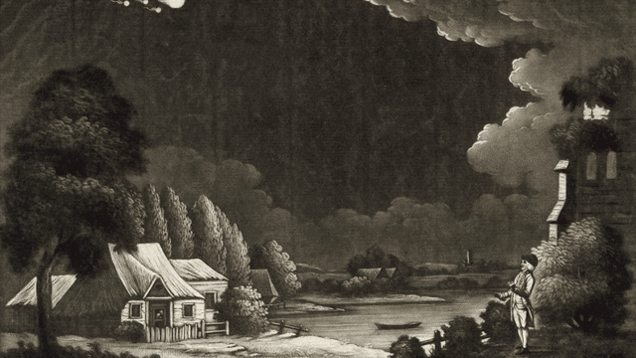

The term meteor comes from the Greek meteoron, meaning phenomenon in the sky. It is used to describe the streak of light produced as matter in the Solar System falls into Earth's atmosphere creating temporary incandescence resulting from atmospheric friction.
A meteoroid is matter revolving around the sun or any object in interplanetary space that is too small to be called an asteroid or a comet. Even smaller particles are called micrometeoroids or cosmic dust grains, which includes any interstellar material that should happen to enter our solar system. A meteorite is a meteoroid that reaches the surface of the Earth without being completely vaporized.


About 25 million meteors enter the Earth's atmosphere every day (duck!). Most burn up and about 1 million kilograms of dust per day settles to the Earth's surface.
Meteorites have proven difficult to classify, but the three broadest groupings are:
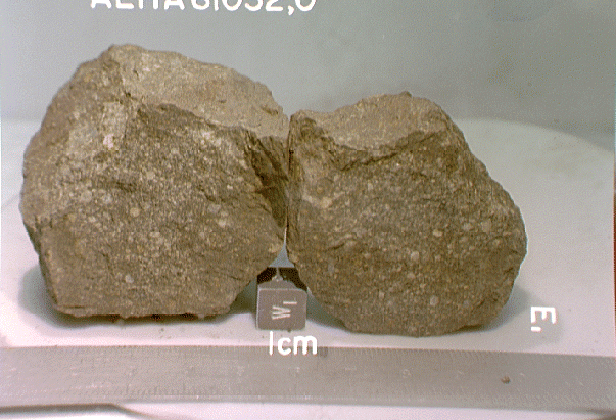

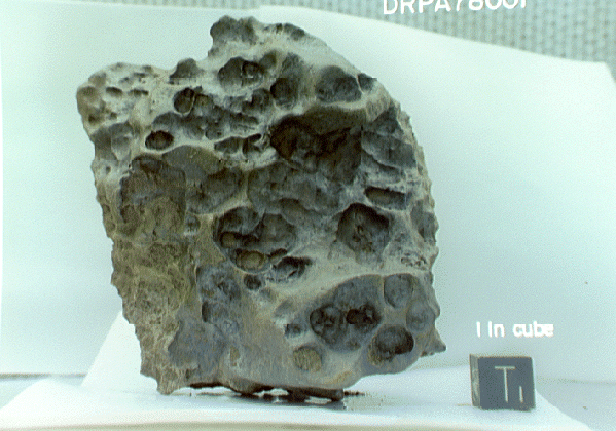
Chondrites Pallasites Irons
The most common meteorites are chondrites, which are stony meteorites. Radiometric dating of chondrites has placed them at the age of 4.55 billion years, which is the approximate age of the Solar System. They are considered pristine samples of early solar system matter, although in many cases their properties have been modified by thermal metamorphism or icy alteration.
Other meteorite types which have been geologically processed are irons and pallasites. Iron meteorites are classified into thirteen major groups and consist primarily of iron-nickel alloys with minor amounts of carbon, sulfur, and phosphorus. These meteorites formed when molten metal segregated from less dense silicate material and cooled, showing another type of melting behavior within meteorite parent bodies. Thus, meteorites contain evidence of changes that occurred on the parent bodies from which they were removed or broken off, presumably by impacts, to be placed in the first of many revolutions. Pallasites are stony iron meteorites composed of olivine enclosed in metal.
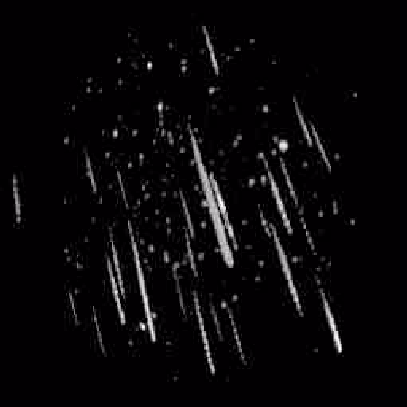
The reason for meteor showers and swarms is shown below. Old comets breakdown into individual rocks over time (several thousand years). These rocks are clustered together at first as a swarm, then later spread out along the old comet orbit. When the Earth passes through the old orbit it encounters a fraction of the meteors causing a shower or swarm.
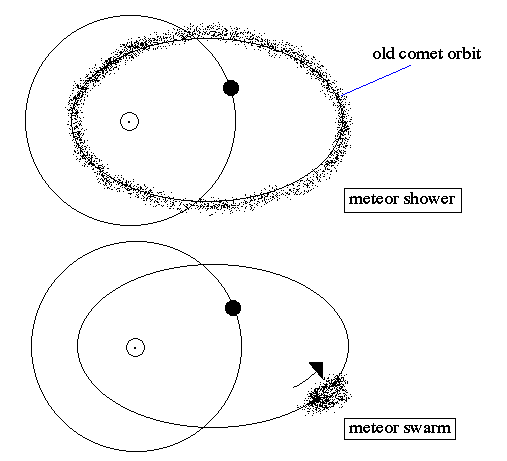
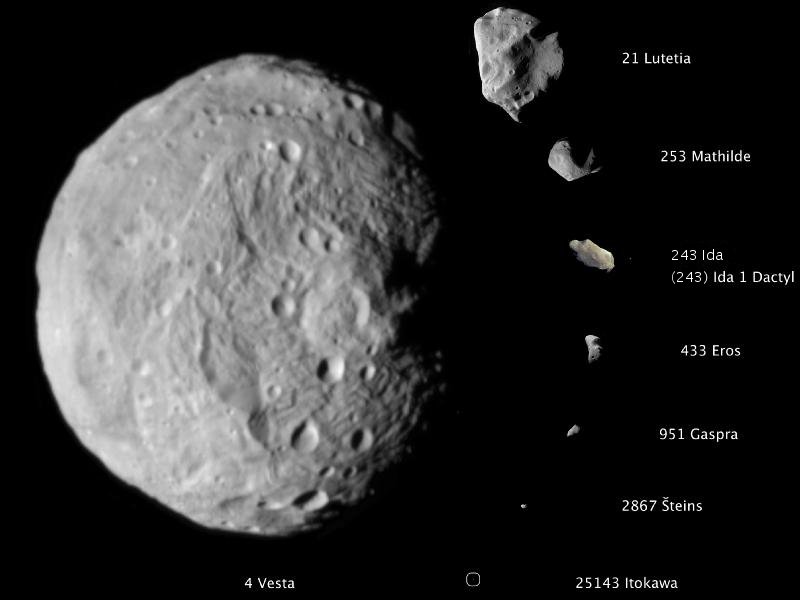
Asteroids are minor planets, especially those of the inner Solar System. The larger ones have also been called planetoids. These terms have historically been applied to any astronomical object orbiting the Sun that did not show the disc of a planet and was not observed to have the characteristics of an active comet. As minor planets in the outer Solar System were discovered and found to have volatile-based surfaces that resemble those of comets, they were often distinguished from asteroids of the asteroid belt. In this article, the term "asteroid" refers to the minor planets of the inner Solar System including those co-orbital with Jupiter.
There are millions of asteroids, many thought to be the shattered remnants of planetesimals, bodies within the young Sun's solar nebula that never grew large enough to become planets. The large majority of known asteroids orbit in the asteroid belt between the orbits of Mars and Jupiter, or are co-orbital with Jupiter (the Jupiter trojans). However, other orbital families exist with significant populations, including the near-Earth objects. Individual asteroids are classified by their characteristic spectra, with the majority falling into three main groups: C-type, M-type, and S-type. These were named after and are generally identified with carbon-rich, metallic, and silicate (stony) compositions, respectively. The size of asteroids varies greatly, some reaching as much as 1000 km across.
Asteroids are differentiated from comets and meteoroids. In the case of comets, the difference is one of composition: while asteroids are mainly composed of mineral and rock, comets are composed of dust and ice. In addition, asteroids formed closer to the sun, preventing the development of the aforementioned cometary ice. The difference between asteroids and meteoroids is mainly one of size: meteoroids have a diameter of less than one meter, whereas asteroids have a diameter of greater than one meter. Finally, meteoroids can be composed of either cometary or asteroidal materials.
The gap between Mars and Jupiter was of great historical interest due to the Bode-Titus relation. In 1801, first minor planet (later termed asteroid) between Mars and Jupiter was discovered. Then followed an increasing number of further discoveries of minor planets.
date asteroid size 1801 Ceres 500km 1802 Pallas 290km 1804 Vesta 260km 1806 Juno 150kmNote the decreasing size indicating that the largest, therefore the brightest, asteroids were the easiest to locate. By 1890, over 300 asteroids had been discovered. By 1990, over 100,000 known asteroids had been found, most with sizes ranging from 10 meters to 100 km and most found in orbits between the Earth's and Saturn's.
Most asteroids are contained within a main belt that exists between the orbits of Mars and Jupiter. Some have orbits that cross Earth's orbit and some have even hit the Earth in times past. One of the best preserved examples is Barringer Meteor Crater near Winslow, Arizona and Clearwater, Canada.
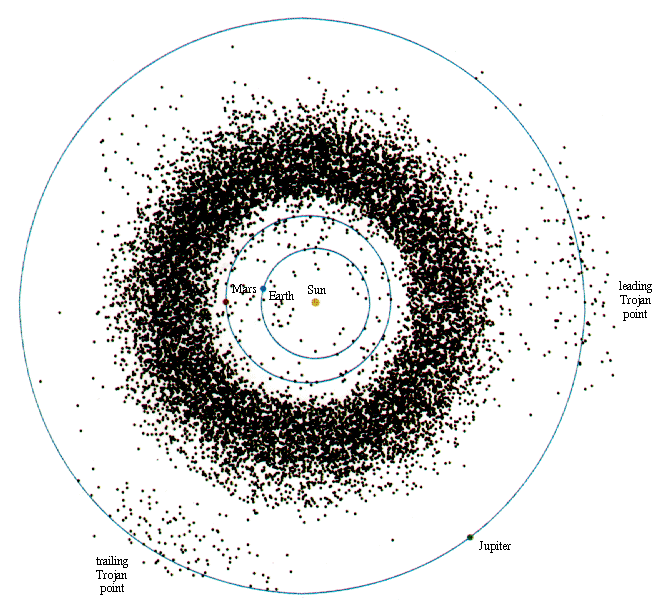
Kirkwood gaps:
If you plot the radius of the orbits of the asteroids you do not get a smooth `bell-curve' shape. Instead, their are interruptions and the numerical value of these `gaps' corresponds to orbital periods that are integer fractions of Jupiter's orbital period.
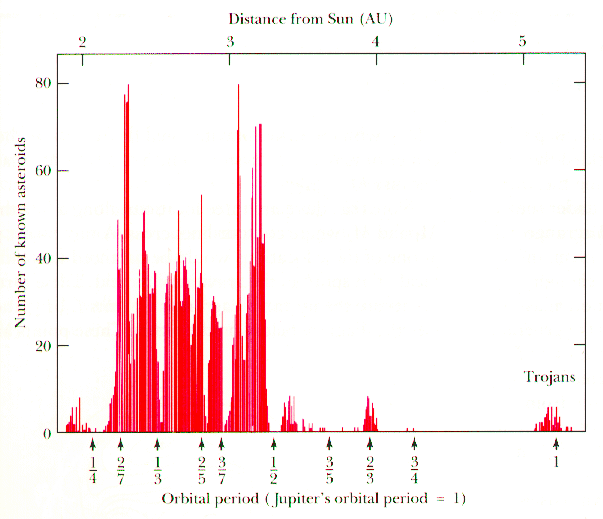
Trojan Family:
Asteroids are gathered into ``families'' based on their orbital characteristics.
The Trojan family of asteroids are located at either the leading or trailing Lagrangian points in Jupiter's orbit. These are two stable points in the gravitational attraction between Jupiter and the Sun. Both points are populated with a cluster of asteroids that have be captured in these stable points over the life of the Solar System.
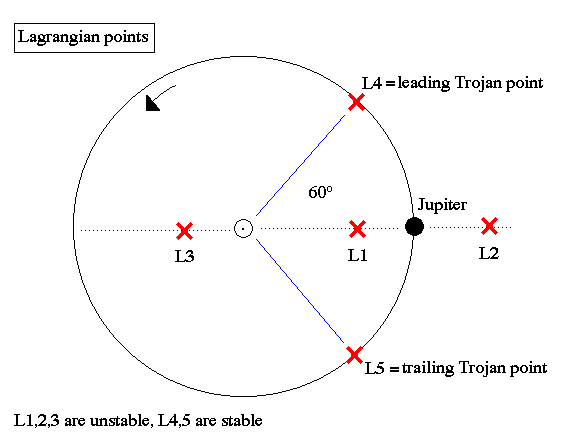
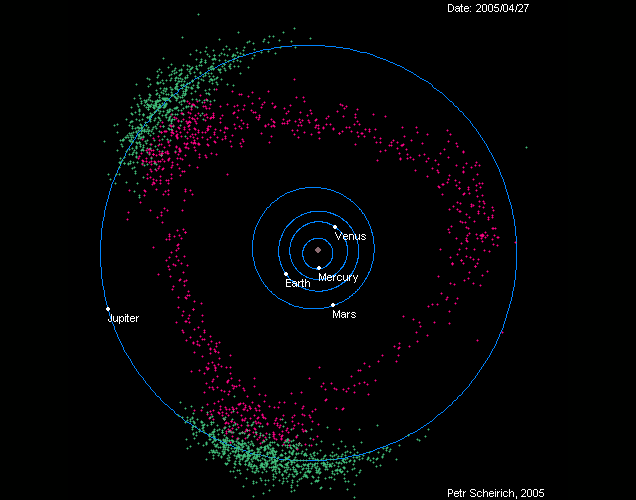

Apollo Family:
The Apollo family of asteroids are those with near-solar orbits. These are objects with highly eccentric orbits that are Earth-crossing. Earth-crossing, of course, means the potential for impact with the Earth (i.e. the objects that caused mass extinctions).
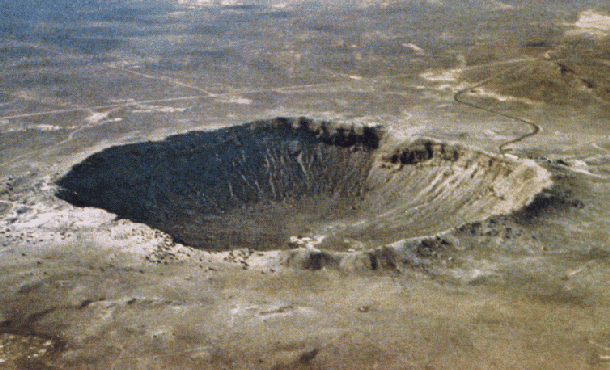
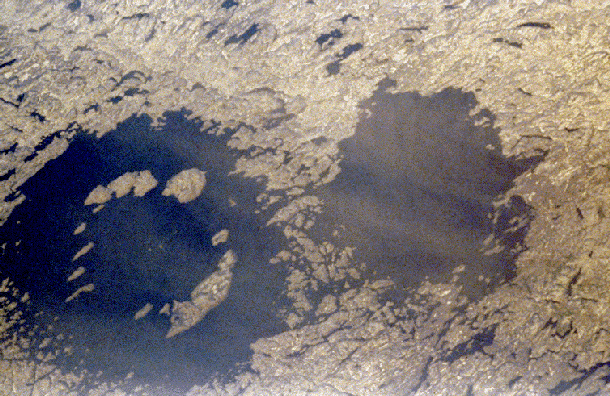
Barringer Clearwater
For reference, a 1 kilometer sized asteroid would impact with the Earth releasing the same energy as a 20,000 megaton blast. It would leave a 13 km sized crater at the impact point and throw enough debris into the atmosphere to cause nuclear winter.
Past near misses:
object name date closest distance Eros 1931 23 million km Icarus 1968 6.4 million km unnamed 200 m object 1972 60 km (!) unnamed 20km object 1988 1.1 million km

Amor Family:
The Amor family are asteroids with Mars-crossing orbits. We believe they evolve by interaction with Mars into Apollo asteroids, so represent a groups of objects in transition.
Hirayama/Koronis Families:
The Hirayama/Koronis families are groups of asteroids that travel in a cluster along the same orbit. They are probably remnants of a single, large body that was broken into a group of smaller asteroids.
Asteroid Composition:
The physical composition of asteroids is varied and in most cases poorly understood. Ceres appears to be composed of a rocky core covered by an icy mantle, where Vesta is thought to have a nickel-iron core, olivine mantle, and basaltic crust. 10 Hygiea, however, which appears to have a uniformly primitive composition of carbonaceous chondrite, is thought to be the largest undifferentiated asteroid. Most of the smaller asteroids are thought to be piles of rubble held together loosely by gravity, though the largest are probably solid. Some asteroids have moons or are co-orbiting binaries: Rubble piles, moons, binaries, and scattered asteroid families are thought to be the results of collisions that disrupted a parent asteroid.
Composition is calculated from three primary sources: albedo, surface spectrum, and density. The last can only be determined accurately by observing the orbits of moons the asteroid might have. So far, every asteroid with moons has turned out to be a rubble pile, a loose conglomeration of rock and metal that may be half empty space by volume.
Asteroids come in three flavors, C-type or carbonaceous, S-type or silicate and M-type or metal.
Well-Studied Asteroids:

951 Gaspra is an S-type asteroid that orbits very close to the inner edge of the asteroid belt. Gaspra was the first asteroid ever to be closely approached when it was visited by the Galileo spacecraft, which flew by on its way to Jupiter on 29 October 1991. Gaspra is an irregular body with dimensions of about 20 x 12 x 11 km. Its surface reflects approximately 20 percent of the sunlight striking it and is likely composed of metal-rich silicates and perhaps blocks of pure metal.

243 Ida is an asteroid in the Koronis family of the asteroid belt named after a nymph from Greek mythology. Later telescopic observations categorized Ida as an S-type asteroid, the most numerous type in the inner asteroid belt. On 28 August 1993, Ida was visited by the Galileo spacecraft while en route to Jupiter. It was the second asteroid visited by a spacecraft and the first found to have a natural satellite.
Ida's orbit lies between the planets Mars and Jupiter, like all main-belt asteroids. Its orbital period is 4.84 years, and its rotation period is 4.63 hours. Ida has an average diameter of 31.4 km (19.5 mi). It is irregularly shaped and elongated, apparently composed of two large objects connected together. Its surface is one of the most heavily cratered in the Solar System, featuring a wide variety of crater sizes and ages. The greatest discovery from the Galileo fly-by was that Ida has a natural satellite, Dactyl. Dactyl is the first natural satellite of an asteroid ever discovered.

Ceres is the largest object in the asteroid belt that lies between the orbits of Mars and Jupiter. Its diameter is approximately 945 kilometers (587 miles), making it the largest of the minor planets within the orbit of Neptune. Composed of rock and ice, Ceres is estimated to compose approximately one third of the mass of the entire asteroid belt. Ceres is the only object in the asteroid belt known to be rounded by its own gravity. Ceres appears to be differentiated into a rocky core and icy mantle, and may have a remnant internal ocean of liquid water under the layer of ice. The surface is probably a mixture of water ice and various hydrated minerals such as carbonates and clay. In January 2014, emissions of water vapor were detected from several regions of Ceres. This was unexpected, because large bodies in the asteroid belt typically do not emit vapor, a hallmark of comets.
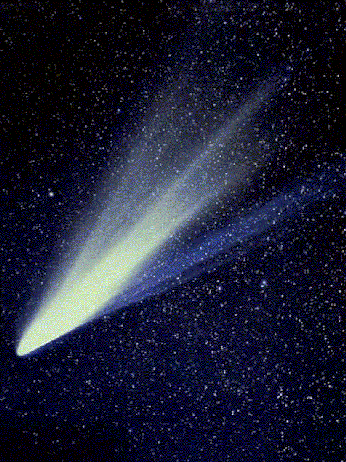
Comets:
Comets are small, fragile, irregularly shaped bodies composed of a mixture of non-volatile grains and frozen gases. They have highly elliptical orbits that bring them very close to the Sun and swing them deeply into space, often beyond the orbit of Pluto. When passing close to the Sun, a comet, warms and begins to release gases, a process called outgassing. This produces a visible atmosphere or coma, and sometimes also a tail. These phenomena are due to the effects of solar radiation and the solar wind acting upon the nucleus of the comet. Comet nuclei range from a few hundred metres to tens of kilometres across and are composed of loose collections of ice, dust, and small rocky particles. The coma may be up to 15 times the Earth's diameter, while the tail may stretch one astronomical unit. If sufficiently bright, a comet may be seen from the Earth without the aid of a telescope.
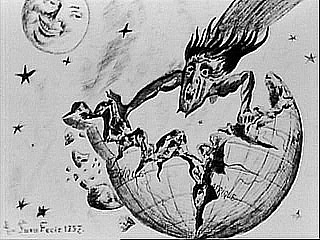
Historically, comets were thought to be atmospheric phenomena to early man, rare and objects of great curiosity. Often comets were used by astrologers to foretell future events.
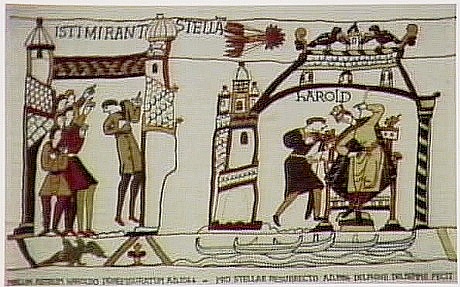
Comets at various times where thought to be ghosts, filled with poisonous gas, demons or cosmic signs; but are actually just asteroids covered in ice. Tycho Brahe showed there was no parallax and that they must be located at distances greater than the Earth's orbit from the Sun.
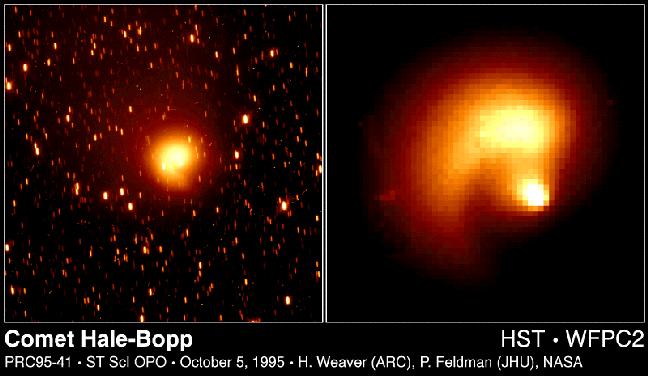
Comet structures are diverse and very dynamic, but they all develop a surrounding cloud of diffuse material, called a coma, that usually grows in size (up to hundreds of km in diameter) and brightness as the comet approaches the Sun.
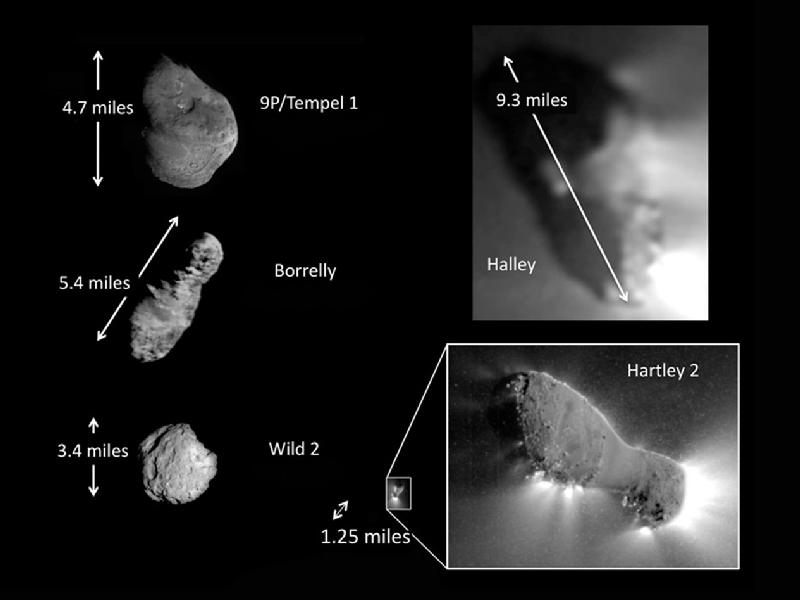
Usually a small, bright nucleus (less than 10 km in diameter) is visible in the middle of the coma. The coma and the nucleus together constitute the head of the comet.
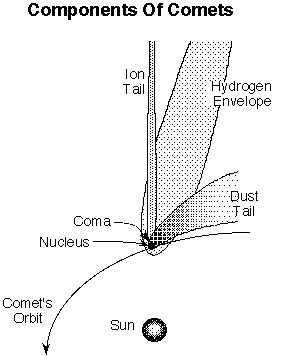
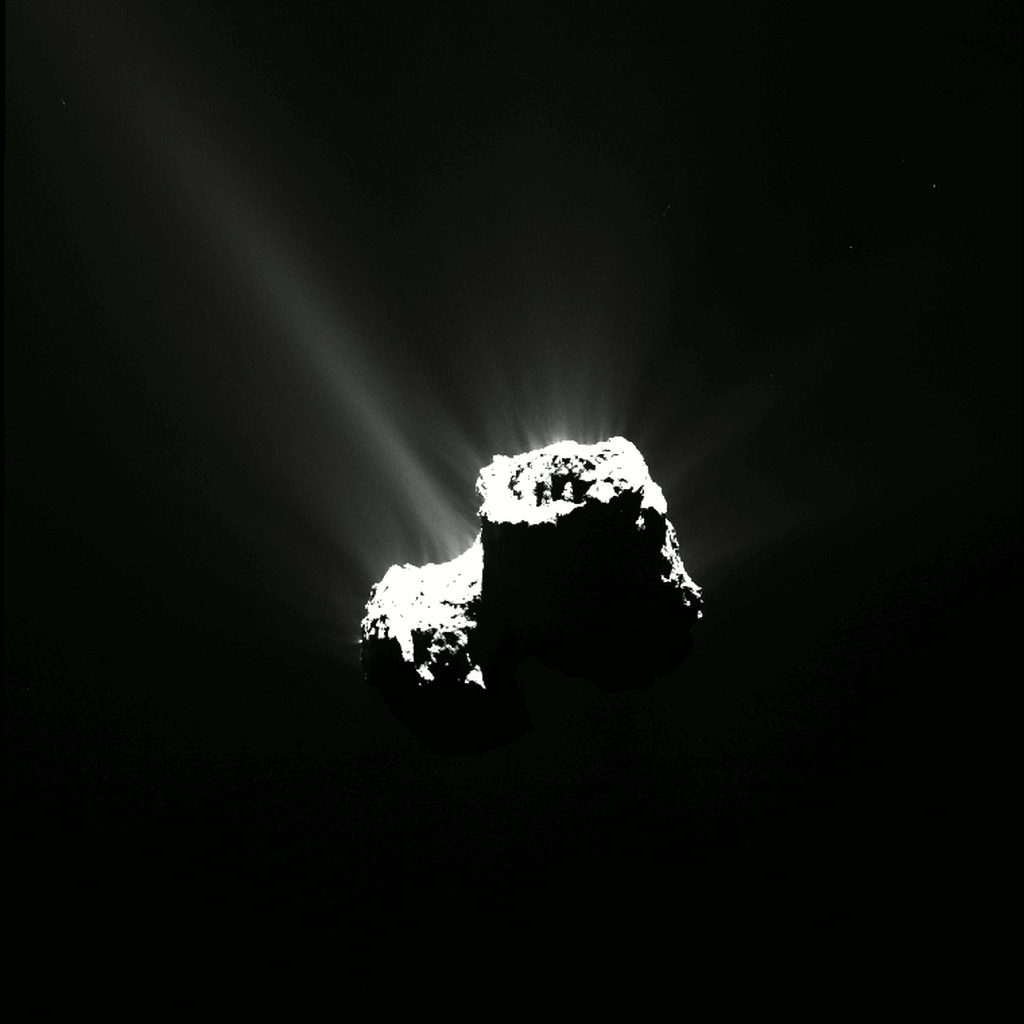
Note that the ion tail points away from the Sun regardless of the orbital motion, thus a comet tail may move in front of the comet's orbit when a comet is leaving the inner Solar System. Each time a comet visits the Sun, it loses some of its volatiles. Eventually, it dissolves into a meteor swarm. For this reason, comets are said to be short-lived, on a cosmological time scale.
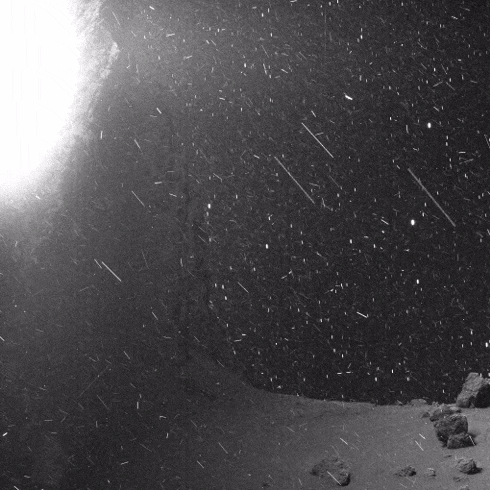
Comets have their origin in the giant Oort cloud that exists outside our Solar System. Perturbations from nearby stars cause the comets in the Oort cloud to fall into the Solar system in hyperbolic orbits (i.e. orbits with only a one time encounter with the inner Solar System).
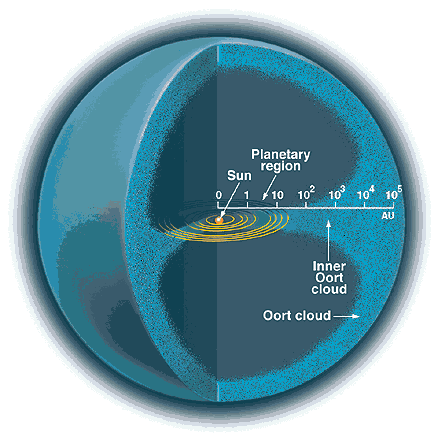
One of the most spectacular events of the century was the impact of Comet Shoemaker-Levy 9 on Jupiter in July 11, 1994.

|
|

|